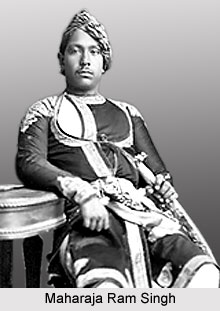 Ram Singh was the ruling Maharaja of the princely state of Bharatpur, during the British rule in India. The state of Bharatpur was established by Maharaja Suraj Mal in the year 1733. He succeeded Maharaja Jashwant Singh and reigned over the state from the year 1893 to 1900. He was born on 21st September 1873 at Lohagarh, Bharatpur as the 2nd son of Jashwant Singh, the Maharaja of Bharatpur who ruled from 1853 to 1893, and Maharani Darya Kaur, his second wife. Ram Singh of Bharatpur belonged to the Sinsiniwar Jat Dynasty. After the death of his father Jashwant Singh on 12th December 1893, Ram Singh succeeded him and ascended the royal throne or gadi of the princely state of Bharatpur on 25th December 1893.
Ram Singh was the ruling Maharaja of the princely state of Bharatpur, during the British rule in India. The state of Bharatpur was established by Maharaja Suraj Mal in the year 1733. He succeeded Maharaja Jashwant Singh and reigned over the state from the year 1893 to 1900. He was born on 21st September 1873 at Lohagarh, Bharatpur as the 2nd son of Jashwant Singh, the Maharaja of Bharatpur who ruled from 1853 to 1893, and Maharani Darya Kaur, his second wife. Ram Singh of Bharatpur belonged to the Sinsiniwar Jat Dynasty. After the death of his father Jashwant Singh on 12th December 1893, Ram Singh succeeded him and ascended the royal throne or gadi of the princely state of Bharatpur on 25th December 1893.
Rule of Ram Singh
According to various historians, Ram Singh led an extravagant lifestyle and had no self-control, which resulted in the deterioration of his health. Moreover, his advisors were rather incompetent and were not much focused on the betterment of the people of Bharatpur. As a result, there was no development of the society during his reign. Moreover, the princely state of Bharatpur faced several administrative difficulties and financial crisis as well. After one of the personal servants (a barber) of Maharaja Ram Singh of Bharatpur was murdered, his ruling powers were suspended August 10th, 1900. Later an enquiry was conducted by the British East India Company and he was deposed on 27th August 1900 and was eventually exiled on 27 August 1900.
Personal Life of Ram Singh
Ram Singh, Maharaja of the princely state of Bharatpur, was first married to Maharani Kishan Kaur on 17th April 1884 at Lohagarh in Bharatpur. She was the daughter of a Zamindar of Tepera, which was located in the district of Aligarh, which is presently located in the northern state of Uttar Pradesh, India. Later on 1st January 1918, his second marriage was held with Maharani Girraj Kaur. The Maharaja had two daughters and two sons, namely Gajindar Kaur, Gokul Kaur, Rao Raja Giriraj Singh and Maharaja Kishan Singh.
Maharaja Ram Singh of Bharatpur died in the year 1929 in exile at Agra. He was succeeded by Maharani Girraj Kaur.



















